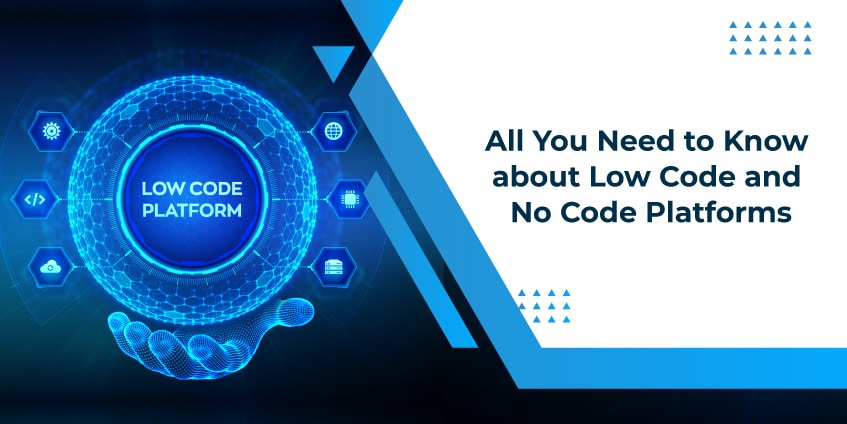Table of Contents
As the demand for software development continues to outpace the availability of skilled developers, low-code and no-code platforms are rapidly transforming the landscape of digital innovation. These platforms enable both developers and non-developers to build applications quickly and efficiently, reducing the time and complexity associated with traditional development. With the continued rise of these platforms in 2024, they are set to accelerate development cycles, enhance business agility, and empower more individuals to become creators.
Let’s explore how low-code and no-code platforms are reshaping development in 2024, the key tools driving this transformation, and what this means for businesses and the future of software creation.
1. What are Low-Code and No-Code Platforms?
Low-code platforms provide a visual development environment where developers can create applications with minimal hand-coding. These platforms offer pre-built components and templates, allowing users to drag and drop functionality into their apps. Low-code platforms still allow for custom coding, but they significantly reduce the amount of manual coding required.
No-code platforms, on the other hand, are designed for non-technical users who have little or no programming knowledge. These platforms enable users to build applications entirely through graphical user interfaces, with no coding required. No-code platforms are ideal for automating workflows, building websites, and creating simple applications.
Key Differences:
- Low-code: Requires minimal coding and allows technical users to build more complex applications.
- No-code: Requires no coding and is designed for non-developers to create basic applications quickly.
2. The Rise of Citizen Developers
One of the most significant benefits of low-code/no-code platforms is the rise of citizen developers—individuals within an organization who are not professional developers but can build applications using these platforms. In 2024, more businesses are leveraging the talents of these employees to meet their software needs, without waiting for IT or engineering teams to become available.
Impact on Businesses:
- Faster Time to Market: Businesses can launch applications, products, and services faster, as teams no longer need to rely solely on professional developers.
- Empowerment of Non-Developers: Teams such as marketing, HR, and operations can create their own tools and solutions without needing extensive coding knowledge.
- Improved Innovation: By democratizing software development, businesses can tap into the creativity and innovation of all employees, driving continuous improvement and problem-solving.
- Example: A marketing manager in an e-commerce company can use a no-code platform like Bubble or Webflow to build a fully functional customer portal without needing assistance from the engineering team.
Forrester predicts that the number of citizen developers will increase by 30% year-over-year, as companies look to fill the talent gap with low-code/no-code solutions.
3. Accelerating Digital Transformation
Low-code and no-code platforms are at the forefront of digital transformation in 2024. Organizations are increasingly looking for ways to streamline their operations, improve customer experiences, and adapt to rapidly changing market conditions. These platforms make it easier for businesses to quickly build and deploy applications that support new digital initiatives.
Key Benefits for Digital Transformation:
- Agility: Low-code/no-code platforms allow businesses to respond quickly to changing customer needs and market conditions. Applications can be built and iterated on rapidly, giving businesses a competitive edge.
- Scalability: Enterprises can scale their digital transformation efforts by empowering different teams to create their own tools and automate workflows. This helps prevent bottlenecks caused by overburdened development teams.
- Cost-Effectiveness: By reducing the need for extensive coding and IT resources, low-code/no-code platforms lower development costs while still delivering enterprise-grade applications.
- Example: The banking industry has adopted low-code platforms like OutSystems to streamline internal workflows, create customer-facing apps, and improve digital banking services, enabling faster feature rollouts and better user experiences.
In a Gartner report, it’s estimated that by 2025, low-code application development will account for over 65% of all app development activity, further driving digital transformation across industries.
4. Simplifying Workflow Automation
Another significant advantage of low-code/no-code platforms is their ability to automate complex workflows and integrate seamlessly with existing systems. By using visual drag-and-drop interfaces, organizations can automate routine processes, reduce manual errors, and improve operational efficiency.
Key Automation Capabilities:
- Automated Workflow Creation: Low-code platforms like Appian and Zoho Creator enable users to design and automate workflows for tasks such as HR onboarding, sales processes, or customer service management.
- Integration with Legacy Systems: These platforms provide connectors to various third-party tools (e.g., CRMs, ERPs, or data management platforms), allowing businesses to integrate their applications with existing infrastructure without major overhauls.
- Data Handling and Analytics: No-code platforms often include built-in analytics tools, helping businesses collect, analyze, and act on data without requiring separate tools or external development teams.
- Example: A company using Zapier or Microsoft Power Automate can easily automate repetitive tasks like data entry, email responses, or project management updates, freeing up employees to focus on higher-value activities.
5. Bridging the Developer Shortage
As the global developer shortage continues into 2024, low-code and no-code platforms are filling a crucial gap. According to a report by IDC, there will be a shortfall of 4 million developers by 2025. This shortage is driving more organizations to adopt platforms that empower non-technical staff to take on development tasks, easing the burden on overstretched IT teams.
Addressing the Developer Gap:
- Faster Development Cycles: With fewer developers available, businesses are looking for ways to shorten development times. Low-code/no-code platforms accelerate the process by allowing non-developers to build and maintain applications.
- Reduced Pressure on IT Teams: These platforms help alleviate the pressure on IT teams, enabling them to focus on more complex and strategic projects, while citizen developers handle smaller-scale applications.
- Improved Productivity: Professional developers can use low-code platforms to speed up routine coding tasks, allowing them to focus on innovation and optimization rather than repetitive tasks.
- Example: Low-code platforms like Mendix allow professional developers to build 50% faster by automating common tasks, such as database integration, user authentication, and UI design.
According to Gartner, the worldwide low-code development technologies market is forecast to reach $26.9 billion by the end of 2024, driven in part by the developer shortage.
6. Top 10 Low-Code/No-Code Platforms in 2024
Here’s a look at the 10 most popular low-code/no-code platforms that are shaping the future of development in 2024, along with their features, use cases, and links to explore more:
| Platform | Type | Key Features | Best For | Website |
|---|---|---|---|---|
| OutSystems | Low-Code | Enterprise-grade app development, AI integration, drag-and-drop UI, cloud-native capabilities | Enterprises needing scalable, secure apps | OutSystems |
| Mendix | Low-Code | Visual modeling, cloud-native, multi-experience apps, collaboration tools | Complex enterprise applications, IoT, mobile apps | Mendix |
| Appian | Low-Code | Workflow automation, business process management (BPM), AI/ML integrations | Automating complex workflows and business processes | Appian |
| Zoho Creator | Low-Code | Custom apps, drag-and-drop builder, cloud integration, database integration | SMBs automating workflows, building dashboards | Zoho Creator |
| Microsoft Power Apps | Low-Code | Connects with Microsoft ecosystem, AI Builder, data visualization, app templates | Internal tools, business apps, enterprise solutions | Power Apps |
| Bubble | No-Code | Fully visual drag-and-drop UI builder, database management, plugin integrations | Non-technical users building full-fledged web apps | Bubble |
| Airtable | No-Code | Spreadsheet-like interface, database management, collaboration tools, automations | Teams managing workflows, simple database-driven apps | Airtable |
| Webflow | No-Code | Visual web development, responsive design, CMS integration, eCommerce features | Designers building responsive websites without code | Webflow |
| Adalo | No-Code | Mobile-first development, drag-and-drop UI, database management, pre-built components | Non-developers building mobile apps quickly | Adalo |
| Glide | No-Code | Google Sheets integration, mobile and web app building, real-time updates | Simple mobile apps for business workflows and data sharing | Glide |
7. Enterprise-Grade Capabilities and Security
Historically, low-code/no-code platforms were considered suitable only for small-scale applications or prototypes. However, in 2024, these platforms are delivering enterprise-grade capabilities that can handle mission-critical applications. They are now equipped with advanced features such as AI integration, cloud-native development, and robust security protocols, making them ideal for large-scale enterprise use.
Enterprise-Grade Features:
- Cloud-Native Architecture: Platforms like Salesforce Lightning and Microsoft Power Apps offer cloud-native development, ensuring scalability and reliability for applications.
- AI and Machine Learning Integration: Many low-code platforms are integrating AI tools, such as chatbots, predictive analytics, and automation features, making it easier for businesses to build intelligent applications.
- Security and Compliance: Low-code platforms are addressing enterprise security concerns by offering built-in encryption, compliance with regulations (e.g., GDPR, HIPAA), and role-based access controls to ensure data security.
- Example: Large enterprises in industries like healthcare and finance are using low-code platforms to build secure, scalable applications that comply with stringent regulatory requirements. Appian is a leading example, providing a platform that meets enterprise security standards while enabling rapid application development.
Conclusion: The Future of Low-Code/No-Code Development
Low-code and no-code platforms are not just a trend—they represent a fundamental shift in how software is developed. In 2024, these platforms are empowering more people than ever to create applications, whether for personal use, business automation, or enterprise solutions. They are accelerating the pace of digital transformation by enabling faster, more agile development, bridging the developer gap, and offering enterprise-grade security and scalability.
As we move forward, AI integration, cloud-native capabilities, and greater customization will continue to push low-code and no-code platforms to new heights, making them an indispensable part of the software development landscape.
Whether you’re a seasoned developer looking to streamline your workflow or a non-technical user looking to bring your ideas to life, low-code and no-code platforms are the key to building the future.
For more updates on low-code/no-code trends and how to accelerate your development, follow us on social media @cerebrixorg!
Ethan Kim
Tech Visionary and Industry Storyteller
Read also
November 19, 2024
November 19, 2024
November 19, 2024

